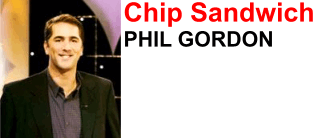
One of the best ways to practice this bedeviling game is to play “sit-and-go” single-table tournaments on the Internet. I play many of these things a week, at many different stakes, on Full Tilt Poker every week. Playing a S&G tournament will give you final table experience — to win, you’ll have to perform well in full table situations and constantly adjust your strategy and tactics as the play becomes increasingly shorthanded. In my mind, there is no better training tool available for the serious student of the game.
At Full Tilt Poker, the sit-and-go tournaments have a generous structure: nine-handed play, six-minute levels (about 15 hands per level). Three players are “paid” with about 50 percent of the prize money being awarded for first place, 30 percent for second place, and 20 percent for third place. All players start with 1,500 in tournament chips.
Early level thoughts and play:
15/30 Level: I play very, very tight during the first level while I’m getting a feel for the table. At the lower limits (100 buy-in and below) there are always a few players at the table that are maniacal. I try to stay out of the way of these guys unless I get a big hand. I’m not scared to put the chips in the pot with pocket aces, kings, queens or ace-king, but I’m not looking to commit a large part of my stack before the flop without one of these premium hands. I’m looking for betting patterns here that I can exploit at critical stages of the tournament — I’m particularly looking for players that play a very loose, aggressive game from late position. I note these players and plan to take advantage of them later. It will not surprise me to see one player eliminated at this level, but one or two players eliminated early will not change my strategy of tight play.
20/40 Level: Again, I play very tight. It will be rare that I’ll have to post more than three total sets of blinds by the end of this level — if I fold every single hand in the 15/30 and 20/40 level, I’ll still have, on average, about 1,350 in chips at the end of this level. In my experience, the average number of players remaining at the end of this level is about eight: tight is still right.
25/50 Level: I have a tight image now, and I’m ready to make my first move. If a loose player “limps” into the pot in middle or late position, I’m willing to raise and try to win the pot from superior position. I’m willing to try to steal the blinds from late position as well. Remember, I’ve been playing absurdly tight for the first two levels, so my raises will get some respect.
30/60 Level: This is a very, very small increase in blinds from the previous level. Much of the strategy from the 25/50 level still applies. I am very careful here to not raise the blinds of short-stacked opponents without a premium hand. Short stacks here will be about 350-500. If I raise a player with that stack and they move in, I’m 100 percent committed to calling them because I’ll almost always be getting the correct odds to do so. However, having a sub-premium hand in this spot is a recipe for becoming a short stack. I’ll take a shot at stealing the blinds if it presents itself.
40/80 Level: By this time, there are usually seven players left in the tournament. I’m going to loosen up my starting hand requirements just a bit, but I’m still going to be very selective preflop from early position. Remember, this is an extremely small increase in blinds from the previous level. I no longer consider limping a valid strategy preflop. If I’m ever going to play a hand and I’m the first to voluntarily commit chips to the pot, I’m raising.
50/100 Level: Usually, there are five or six players left in the tournament at this level. That puts the average chip stack at around 2,600 or so. Players are not feeling the “squeeze” unless they have about 1,000 in chips or fewer. But I still have to loosen up a bit because the blinds are coming around very quickly. “Sitting out” for the entire level will be catastrophic to the stack — I’ll lose at least three sets of blinds for a combined 450 loss should I get too tight here. I try to pick up at least one blind steal during this level. If there are still seven or eight players left in the tournament, realize that big conflicts are coming — a raise and a reraise virtually force the players all-in.
Five players remaining:
With just two spots to the money, this is a great time to get aggressive. In my experience, there are usually five players left in the tournament at around the $80/$160 level of blinds. The average stack at this level is $2,700.
- If I am below five or six big blinds at this level ($800-$1,000 in chips) I will play very aggressively and just take a shot at stealing the blinds or doubling up. I find that most players are waiting for players to bust out and are unwilling to commit $800 to the pot to do so. I particularly look to steal the blinds from players with average stacks — they can afford to fold and are unlikely to want to commit a large number of chips to the pot.
- If I am a big stack ($4,000-plus) at this point, there will be at least one or two small stacks. But I realize that the small stacks are still capable of inflicting some damage. Even a loss of $800 at this point in the tournament can bring me from big stack back to average. I’m looking to steal from the average stacks and get the money in with the best hand against the small stacks. If there is another big stack at the table, all the rest of the players remaining will have small stacks — I am very careful not to get into a situation where I can get squeezed and frozen out of the pot (i.e. the “Fish and Chip Sandwich” play).
Four players remaining:
One spot left to the money, most players in the sit-and-go will play far too tight for the blinds. Instead of raising three times the big blind, I find that a minimum raise will often get the job done — any raise is enough to get the remaining players to fold. I am very careful here about playing a hand from the small blind if the big blind is a short stack — this is often a way to get caught in the chip sandwich. The real key to a four-handed game is to make sure that if you put chips into the pot, you’ll get to see the flop if you don’t have the best hand or you’ll get all-in before the flop with the best hand. One of the worst things that can happen to you in a four-handed game is having to fold the hand after raising the pot — with the big blind often at $200, a preflop raise of three times the big blind ($600) will always be nearly one-fifth of your stack.
The bubble bursts:
After the bubble has burst and the sit-and-go is reduced to three players, it is time to get very aggressive — the shorter the stack, the more aggressive you have to be. Remember, if you have the shortest stack, you’re expected to go out in third place. Give yourself a fighting chance to win by taking a stand early and often.
Try to be the player that makes the last move. If you’re the last player to put chips into the pot, you have some “folding equity” — your opponent has a chance to fold an inferior hand. With that in mind, consider making a “stop-and-go” play with 6-8 big blinds:
- The player on the button raises to three times the big blind.
- You just call.
- No matter what the flop is, you move all-in for the rest of your chips.
Remember, your opponent is pot committed if you raise all-in before the flop and you will not be making the last move — your opponent is definitely going to call. By waiting for the flop, there is a good chance that you can get your opponent to incorrectly fold. Your opponent, playing any two unpaired hole cards, will only flop a pair or better about 32.4 percent of the time. If your opponent misses the flop, there is a good chance you can take down the pot with the automatic post-flop all-in. If they don’t miss the flop, you were unlikely to win the pot anyway.
Heads-up:
If you get to heads-up, realize that the blinds will nearly always be quite significant and that both players will have an average of about 15 big blinds. Heads-up is tough, and with the blinds so big, it is even tougher. I recommend playing almost every single hand you’re dealt when you’re on the button — raise 2½ times the big blind with about 65 percent of the hands, limp and just complete the blind 30 percent of the time, and fold 5 percent of the time. When limping, make sure that for every three times you limp with a bad hand you’re willing to fold to a raise, you limp with a good hand you’re willing to move all-in with before the flop.
Conclusion:
All in all, sit-and-go tourneys are a great way to practice the skills necessary to win a big poker tournament. It is a mini-tournament that very closely simulates all the stages of a bigger, longer, uncut tournament. When I’m playing at Full Tilt Poker, I know that my practice will pay off not only for my charity (I donate all my online winnings to the Cancer Research and Prevention Foundation), but also in better results in the big tournaments.
 If you’re USA-based, like Phil, you can play some great online at Bookmaker Poker or BetOnline Poker.
If you’re USA-based, like Phil, you can play some great online at Bookmaker Poker or BetOnline Poker.

![]() If you’re USA-based, play online at Bookmaker Poker or BetOnline Poker, they’re safe, reputable poker rooms that welcome American players.
If you’re USA-based, play online at Bookmaker Poker or BetOnline Poker, they’re safe, reputable poker rooms that welcome American players.
 Have you tried the Microgaming Poker Network? It’s got some great features, excellent tournaments and offers some of the best cash game play available online. Check out
Have you tried the Microgaming Poker Network? It’s got some great features, excellent tournaments and offers some of the best cash game play available online. Check out 



 If you’re USA-based, like Phil, you can play some great online at
If you’re USA-based, like Phil, you can play some great online at 

 If you’re USA-based, like Phil, you can play some great online at
If you’re USA-based, like Phil, you can play some great online at